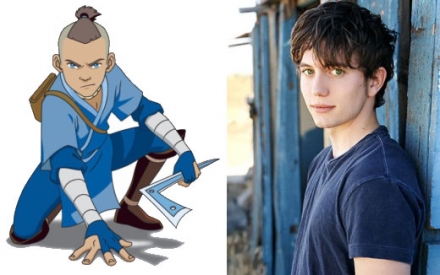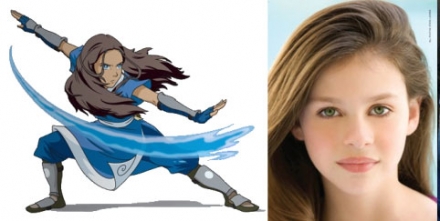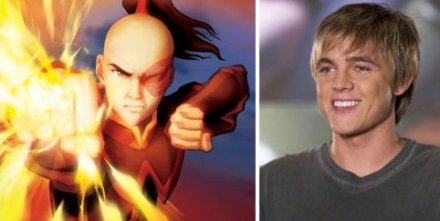Fear of a Black (Fantasy) Planet
No time for a list of things just yet.
The casting for the live-action version of Avatar: The Last Airbender has been announced. See if you can spot a problem:



It's not an isolated event.Between the many movies about POC that feature a primary white protagonist (Dances with Wolves, Last Samurai, Last of the Mohicans, Forbidden Kingdom) [see also " Wiscon 31: What These People Need Is a Honky"-TS], to white washing (Bury My Heart at Wounded Knee, Wizard of Earthsea, Prince of Persia), it's really more than simply "White people will only see movies with white people".
If that were the real reason, why even have stories set in POC cultures, or whitewash POC characters- why not just make all white stories to begin with or remake POC stories minus the cultural trappings(Resevoir Dogs, The Ring, etc.)?
The revelation caused some shock among the Ojousaw household because of, you know, the racism. ojouchan was particularly upset yesterday. She's worried about our children, who will be brown, and who will look to the few characters who look like them, then wonder why they get changed to look like the people who don't. She's worried about her niece, who recently told her momma, "My favorite color is going to be brown, because that's what color my skin is, and nobody likes it." She's only four. I'm worried too, but it's still not as real for me yet.
But that's why I find it utterly heartwrenching that M. Night Shyamalan, who decided or at the very least signed off on the idea that all of these beautiful characters of color are better off being all-white, was initially drawn to the project because his Indian-American daughters loved the show so much they wanted to dress up as Katara.
There's been more outrage than wanky defensiveness, thankfully. I haven't heard the "I'm sure they're the best actors" argument yet, for example. There's also the argument that because the series is set in a fantasy world, there isn't actually any intersection between race and skin color as it exists in our world (ergo, somehow, everyone should be white), an argument also used in the Earthsea adaptations. But the one that's just hovering on the horizon (possibly forestalled because there are, as yet, no pictures of the actor playing Aang) is that some or all of the characters are white anyway. There've been a lot of discussion on this before too, like Naamenblog's essay "Anime/Manga Characters =/= White."I had a huge disconnect recently when I heard someone on the street say to a friend that one of my favorite shows, Avatar: The Last Airbender, was great but why were all the characters white? My head jerked around so quick I almost got whiplash. I didn't understand how she could see those characters as white and before I could find a way to insert myself into their conversation and question her about this they were gone. It’s something I couldn't help but think about though.
His post was in response to a marvelous one by Yeloson (again) that is no longer available.
On the other hand, this essay just fell into my lap, "The Face of the Other" or "Do Manga Characters Look White?"Interestingly, in a manga in which Chinese or European characters are the majority, such as a story set in China or Europe, majority characters are generally drawn exactly as Japanese characters would be drawn in a manga set in Japan, without any racial stereotyping at all. In the context of such a story, the Chinese or European characters are not Other, and markings of Otherness would be superfluous. The artist would make the foreign setting obvious through names, clothing, customs, architecture, and "props," rather than burdening every character with stereotyped racial features, which would limit her ability to distinguish characters from each other, and would also make it difficult for readers to identify with protagonists. Furthermore, if a Japanese character appears in such a story, she will usually be marked visually as Japanese, although usually only by black hair and eyes. (Readers are often expected to identify with such characters, and more exaggerated markings would interfere with that identification.)
Racial markings in manga, therefore, are generally relative. By contrast, an American comic book set in Japan or China would most likely portray every character with stereotyped racial signifiers (and probably with contrived accents, as well). It may be that Westerners, accustomed to non-relative, standardized racial markers, are baffled by the Japanese system of relative signification, in which a single artist may portray a Chinese character one way in one story (set in Japan), and very differently in another (set in China).
As a side note, "The Face of the Other" was linked in an article on Racialicious about videogames, specifically the Xbox release of Black College Football: The Xperience. I'm not really a fan of sports videogames. But: BCFx will also come with support for the Rock Band drum set to tap into the popularity of drumlines at HBCU football games. The game will ship with 35 songs and 65 musical cadences.
Which is probably the most awesome videogame news I've heard recently.
The casting for the live-action version of Avatar: The Last Airbender has been announced. See if you can spot a problem:



It's not an isolated event.Between the many movies about POC that feature a primary white protagonist (Dances with Wolves, Last Samurai, Last of the Mohicans, Forbidden Kingdom) [see also " Wiscon 31: What These People Need Is a Honky"-TS], to white washing (Bury My Heart at Wounded Knee, Wizard of Earthsea, Prince of Persia), it's really more than simply "White people will only see movies with white people".
If that were the real reason, why even have stories set in POC cultures, or whitewash POC characters- why not just make all white stories to begin with or remake POC stories minus the cultural trappings(Resevoir Dogs, The Ring, etc.)?
The revelation caused some shock among the Ojousaw household because of, you know, the racism. ojouchan was particularly upset yesterday. She's worried about our children, who will be brown, and who will look to the few characters who look like them, then wonder why they get changed to look like the people who don't. She's worried about her niece, who recently told her momma, "My favorite color is going to be brown, because that's what color my skin is, and nobody likes it." She's only four. I'm worried too, but it's still not as real for me yet.
But that's why I find it utterly heartwrenching that M. Night Shyamalan, who decided or at the very least signed off on the idea that all of these beautiful characters of color are better off being all-white, was initially drawn to the project because his Indian-American daughters loved the show so much they wanted to dress up as Katara.
There's been more outrage than wanky defensiveness, thankfully. I haven't heard the "I'm sure they're the best actors" argument yet, for example. There's also the argument that because the series is set in a fantasy world, there isn't actually any intersection between race and skin color as it exists in our world (ergo, somehow, everyone should be white), an argument also used in the Earthsea adaptations. But the one that's just hovering on the horizon (possibly forestalled because there are, as yet, no pictures of the actor playing Aang) is that some or all of the characters are white anyway. There've been a lot of discussion on this before too, like Naamenblog's essay "Anime/Manga Characters =/= White."I had a huge disconnect recently when I heard someone on the street say to a friend that one of my favorite shows, Avatar: The Last Airbender, was great but why were all the characters white? My head jerked around so quick I almost got whiplash. I didn't understand how she could see those characters as white and before I could find a way to insert myself into their conversation and question her about this they were gone. It’s something I couldn't help but think about though.
His post was in response to a marvelous one by Yeloson (again) that is no longer available.
On the other hand, this essay just fell into my lap, "The Face of the Other" or "Do Manga Characters Look White?"Interestingly, in a manga in which Chinese or European characters are the majority, such as a story set in China or Europe, majority characters are generally drawn exactly as Japanese characters would be drawn in a manga set in Japan, without any racial stereotyping at all. In the context of such a story, the Chinese or European characters are not Other, and markings of Otherness would be superfluous. The artist would make the foreign setting obvious through names, clothing, customs, architecture, and "props," rather than burdening every character with stereotyped racial features, which would limit her ability to distinguish characters from each other, and would also make it difficult for readers to identify with protagonists. Furthermore, if a Japanese character appears in such a story, she will usually be marked visually as Japanese, although usually only by black hair and eyes. (Readers are often expected to identify with such characters, and more exaggerated markings would interfere with that identification.)
Racial markings in manga, therefore, are generally relative. By contrast, an American comic book set in Japan or China would most likely portray every character with stereotyped racial signifiers (and probably with contrived accents, as well). It may be that Westerners, accustomed to non-relative, standardized racial markers, are baffled by the Japanese system of relative signification, in which a single artist may portray a Chinese character one way in one story (set in Japan), and very differently in another (set in China).
As a side note, "The Face of the Other" was linked in an article on Racialicious about videogames, specifically the Xbox release of Black College Football: The Xperience. I'm not really a fan of sports videogames. But: BCFx will also come with support for the Rock Band drum set to tap into the popularity of drumlines at HBCU football games. The game will ship with 35 songs and 65 musical cadences.
Which is probably the most awesome videogame news I've heard recently.